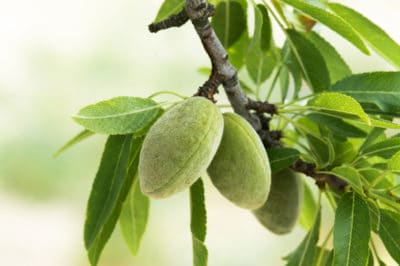Things to Consider before You Plant
Almond trees adore hot, dry climates. But during winter dormancy, they also need between 250 and 500 hours of temperatures in the 33°F to 45°F range (0.55° to 7.2°C). Tropical climates can’t provide these chilling hours. Among other facts to consider before planting an almond tree:
- In the United States, almond trees bloom in February. That eliminates anywhere with an average last spring frost date later than January.
- Most almond tree varieties suffer damaged flowers after more than 30 minutes at temperatures below 24.8°F (-4°C).
- During extremely hot, dry summers, water-deprived almond trees yield much smaller nuts.
- If cold, rainy spring weather discourages bees from pollinating their flowers, almond trees set less fruit.
- Bacterial and fungal diseases that thrive in wet or humid conditions also decrease a tree’s yield.
Expert gardener’s tip: An almond tree typically uses 1 gallon (3.78 liters) of water for each full-sized almond it produces. And it needs year-round watering.
The Best Places to Grow Almonds
Where can you find the perfect almond-growing climate? Anywhere with a Mediterranean climate where summer’s cold ocean currents mean mild, dry weather and the warmest months average 72°F (22.2°C). In winter, warm ocean currents bring mild, moist air and rain. In such a climate, yearly rainfall seldom exceeds 20 inches.
The World’s Biggest Almond Producers
More than four of every five commercially grown almonds come from a 400-mile swath of California’s Central Valley farms. They stretch from Kern County in the south to Tehama County in the north. Rounding out the top five global producers are:
- Spain
- Italy
- Iran
- Syria
Growing Almonds by USDA Zone
Depending on variety, almond trees grow in USDA zones 5 through 10. And even in these zones, winter chilling requirements still apply. For the best chance of success, choose a low-chill cultivar such as ‘Ne Plus’ or ‘Garden Prince,’ at 250 chill hours each. They grow in USDA zones 6 through 10 and 7 through 10, respectively.
Expert gardener’s tip: Wherever they grow, all almond trees need sites with full, direct sun and rapidly draining soil. If waters accumulate around their roots, they’re more likely to develop root rot.
